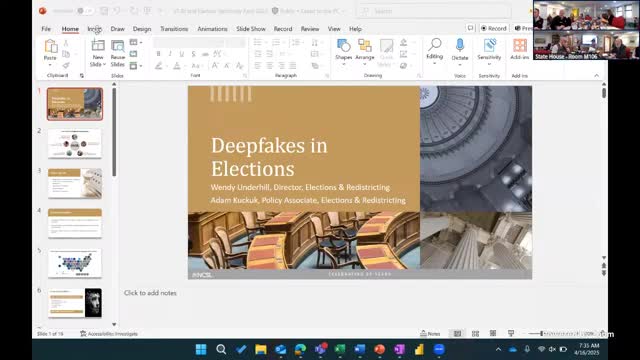
This article was created by AI using a video recording of the meeting. It summarizes the key points discussed, but for full details and context, please refer to the video of the full meeting. Link to Full Meeting
Wendy and Adam, representatives from the National Conference of State Legislatures (NCSL), opened the discussion by emphasizing the importance of understanding how deepfakes could be used for deception in political campaigns. They noted that while AI has potential benefits, the focus of the meeting was on its risks, particularly regarding misinformation.

Before you scroll further...
Get access to the words and decisions of your elected officials for free!
Subscribe for FreeThe conversation revealed that 23 states have enacted laws to regulate deepfakes in elections, with varying definitions and enforcement mechanisms. Some states, like Minnesota and Texas, have implemented prohibitions on publishing election-related deepfakes within a certain timeframe before elections, while others require disclosures indicating that media has been generated or altered by AI. For instance, Colorado mandates that metadata of deepfakes include details about the AI tools used in their creation.
Adam pointed out that many of these laws remain untested in courts, raising questions about their applicability and enforcement. A notable case from California, Coles v. Bonta, challenges the constitutionality of such laws, arguing they infringe on free speech rights. The court has temporarily halted enforcement while the case is under review.
Wendy shared insights from a recent study indicating that the use of disclaimers in political ads featuring deepfakes may actually reduce trust in the candidates behind them. This finding underscores the complexity of navigating AI's impact on public perception and electoral integrity.
As the meeting concluded, both speakers acknowledged the need for ongoing monitoring of how these laws are implemented and enforced, particularly as technology continues to evolve. The discussions set the stage for future legislative efforts aimed at balancing the right to free speech with the necessity of transparency in political messaging.
Converted from House Government Operations-2025-04-16-9:30AM meeting on April 17, 2025
Link to Full Meeting
Comments
View full meeting
This article is based on a recent meeting—watch the full video and explore the complete transcript for deeper insights into the discussion.
View full meeting



